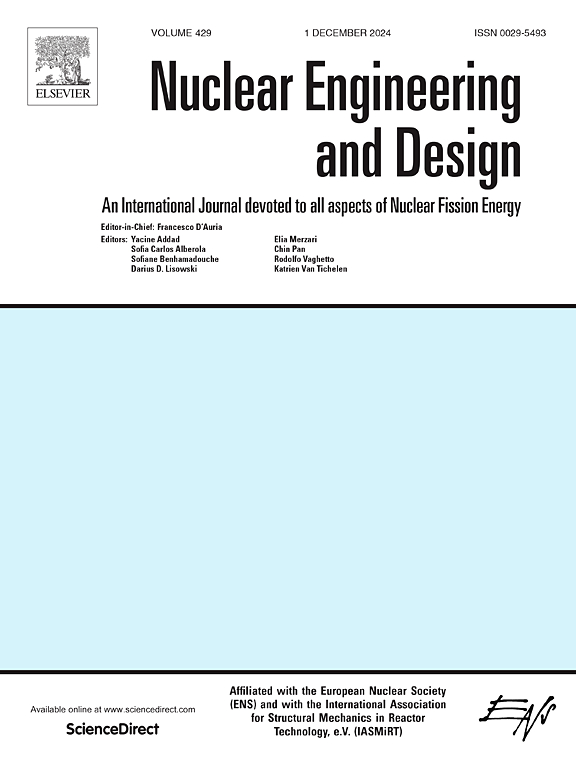Neutronics and thermal hydraulics multiscale simulation of a lead-cooled fast reactor
IF 2.1
3区 工程技术
Q1 NUCLEAR SCIENCE & TECHNOLOGY
引用次数: 0
Abstract
In this work, the application of an upscaling methodology to the thermal hydraulic model of an LFR is presented. The upscaling process is applied to local equations, where a rigorous mathematical process yields reactor-scale equations containing information from the pin scale, in addition to information on the properties of each phase. Two phases are considered: the fuel rods are the solid phase, and the lead coolant is the liquid phase. The upscaled thermal model is coupled with a neutron model, a simplified expression of the diffusion equation that considers reactivity feedback. The scaled thermal hydraulic model allows the entire core to be analyzed using only two heat transfer equations, which contain scaled coefficients for both phases. These were calculated at different lead velocities to understand their behavior under potential velocity changes. The core neutron parameters were calculated using the Serpent code, and the models and coupling were implemented in COMSOL Multiphysics. The results show that the neutron flux profiles, fuel and coolant temperatures behave as the reactor design values.
铅冷快堆的中子学和热工力学多尺度模拟
在这项工作中,提出了一种升级方法在LFR热水力模型中的应用。升级过程应用于局部方程,其中严格的数学过程产生包含引脚尺度信息的反应器尺度方程,以及每个相属性的信息。考虑两相:燃料棒是固相,铅冷却剂是液相。升级的热模型与中子模型耦合,中子模型是考虑反应性反馈的扩散方程的简化表达式。比例热水力模型允许整个核心只使用两个传热方程进行分析,其中包含两个阶段的比例系数。这些是在不同的导联速度下计算的,以了解它们在潜在速度变化下的行为。利用Serpent代码计算堆芯中子参数,并在COMSOL Multiphysics中实现模型和耦合。结果表明,中子通量分布、燃料和冷却剂温度符合反应堆设计值。
本文章由计算机程序翻译,如有差异,请以英文原文为准。
求助全文
约1分钟内获得全文
求助全文
来源期刊

Nuclear Engineering and Design
工程技术-核科学技术
CiteScore
3.40
自引率
11.80%
发文量
377
审稿时长
5 months
期刊介绍:
Nuclear Engineering and Design covers the wide range of disciplines involved in the engineering, design, safety and construction of nuclear fission reactors. The Editors welcome papers both on applied and innovative aspects and developments in nuclear science and technology.
Fundamentals of Reactor Design include:
• Thermal-Hydraulics and Core Physics
• Safety Analysis, Risk Assessment (PSA)
• Structural and Mechanical Engineering
• Materials Science
• Fuel Behavior and Design
• Structural Plant Design
• Engineering of Reactor Components
• Experiments
Aspects beyond fundamentals of Reactor Design covered:
• Accident Mitigation Measures
• Reactor Control Systems
• Licensing Issues
• Safeguard Engineering
• Economy of Plants
• Reprocessing / Waste Disposal
• Applications of Nuclear Energy
• Maintenance
• Decommissioning
Papers on new reactor ideas and developments (Generation IV reactors) such as inherently safe modular HTRs, High Performance LWRs/HWRs and LMFBs/GFR will be considered; Actinide Burners, Accelerator Driven Systems, Energy Amplifiers and other special designs of power and research reactors and their applications are also encouraged.
 求助内容:
求助内容: 应助结果提醒方式:
应助结果提醒方式:


